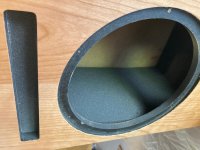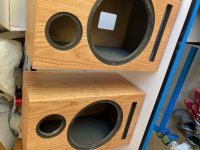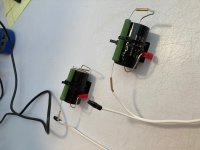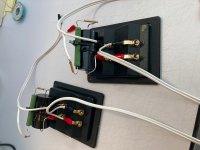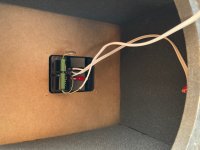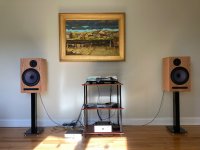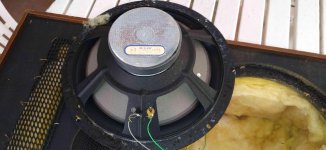Hmmmmm.
I'll take a stab at this one.
I was tempted for something similar only more disastrous, a mttm with 10's. And 4" framed tweets. 6db crossing at 2khz.
Seems people liked the tekton pendragon or enzo with 3 x domes, even with dispersion.
Ideally a mtm crosses at the frequency where the dispersion narrows total outside distance.
So 2 x 10" plus 3" for a tweet would be a cone distance 23", say 20 due to narrowing dispersion of a 10" past 1400hz.
1129ft (per sec) / 20" would be the dispersion of a 20" in the vertical.
So maybe 400hz.
Ideally it is closer to a point source, or disperson match tweet woof at xover.
My buddy crossed 2 x 6.5" below 2khz (i think), it didn't measure better than a higher frequency but sounded better.
That being said, some don't like the sound of d'apollito, more focused or more like sound coming at you from a tunnel.
I'm learning that dispersion can be a factor, i read one loved a tractrix horn, until he stood up (it narrows dispersion the higherr you go), it drove him nuts.
I made a 4x4" tang band full range focused array, the dispersion was so tight that when you stood it you felt a little dizzy, like a head cold hit your hearing. The 9x4" focused array didn't do that, but it really involved the room also, badly needed baffle step, nothing below 150hz, and don't make a bunch of 6" cube enclosures, they peak past 1khz.......
Ive made stuff people said would suck.
It didn't.
You have to remember that you are making something very specific.
It can be a give and take.
You can pick up one area then be worse in others.
So,
If making sawdust is free for you, go for it.
I don't regret anything made, learned from all, and later learned how to make it better.
Those are nice parts that can be reused.
I'd imagine a big mtm wouldn't work, but my double 15" to tweet horn tmm sounded fine crossed at 750hz. Not sure if it would have worked as well as an mtm though.
I think if you wire the 2 a26 in parallel you pick up 6db, would that match the tweet ?
MTM, I will be modelling this carefully first, "is it possible?" I don't know at the moment but will look at it carefully.
TMM will look at that also, interesting that you tried a TMM @ 750Hz, were the bass just paralleled up? I built a TMM with a 6 1/2" SEAS CA17RCY/P 25TFF combination abot 15 years ago now, it worked OK.
6 db gain with 2 A26s, yes as the bass are 89 db that matches the 95 db sensitivity of the T35 tweeter fine, however another complication here more will be expected from the tweeter without the resistor.
A bit for me to think about then
yup, parallel 15's.
you will have to change the cap value also.
There is a thread here by o'dougbo on mtm vs tmm not long ago.
Sounded similar, but mtm was more focused (missing floor and ceiling bounce of some frequencies ?).
people liked the "look" of mtm better.
What is the pole of the standard cap plus tweet ?
I'd look into sliding the tweeter back for a better step response.
Made mine sound better.
Seated, your mtm may be fine, but standing or standing off axis will probably sound very much worse.
And speaking from experience, that get's annoying, quick.
you will have to change the cap value also.
There is a thread here by o'dougbo on mtm vs tmm not long ago.
Sounded similar, but mtm was more focused (missing floor and ceiling bounce of some frequencies ?).
people liked the "look" of mtm better.
What is the pole of the standard cap plus tweet ?
I'd look into sliding the tweeter back for a better step response.
Made mine sound better.
Seated, your mtm may be fine, but standing or standing off axis will probably sound very much worse.
And speaking from experience, that get's annoying, quick.
Last edited:
Any news darkmatter ?
I'm not sure about a tmm.
If you made seperate box for the 2nd woofer, you can re-use it if not working.
Then again, klipsch used dual 10" crosses at 2.2k for the old rf7.
Or the tekton pendragon, or enzo...........
But they cross maybe low 1khz +.
Dual 10" in mtttm or tttmm.
Tekton Design Pendragon Tower Speakers Review - HomeTheaterHifi.com
Tekton Design Enzo XL loudspeaker | Stereophile.com
I'm not sure about a tmm.
If you made seperate box for the 2nd woofer, you can re-use it if not working.
Then again, klipsch used dual 10" crosses at 2.2k for the old rf7.
Or the tekton pendragon, or enzo...........
But they cross maybe low 1khz +.
Dual 10" in mtttm or tttmm.
Tekton Design Pendragon Tower Speakers Review - HomeTheaterHifi.com
Tekton Design Enzo XL loudspeaker | Stereophile.com
How about an A36!
I've purchased the A26 kit and decided to clone the Dynaco A35; hence I'm calling this project the A36. The cabinets are made of "3 quarter" birch plywood and we kept the cabs to the original Dynaco design; except that we made them just a tad bigger here and there. I've finally got them here tonight as a friend was building the cabs for me. I hooked everything up and was delighted with the T35 tweeter: extended, clear, sweet. The woofer was really tight in the beginning, but after a couple of hours it loosened up and the bass is tuneful now, although not as low in response as I would like. I've still got some work to do to fine tune the speaker, but for the record, it is one of the finest speakers to grace my challenging living room environment. I'm smitten.
I built the madisound A26 kit. I chose the T35 tweeter, mundorf supreme capacitor and the 10 ohm resistor. I'm using an accuphase P-300 amp with C-200 preamp. The A26 sounds great. It has good tight bass and overall is exceptionally clear. The sound is forward and direct meaning it doesn't sound like it's playing through a tube like some speakers. I tried using a vifa d27tg35-06 tweeter as a comparison test to the T35 tweeter. The T-35 tweeter is what makes this speaker so exceptional. The vifa tweeter in comparison was tinny and brassy where the T-35 is exceptionally clear and musical. There is some sound stage but not very large. The speakers sound much larger than their conservative small size. I have owned the original Dynaco A25 in comparison the A26 does everything better and sounds clearer and can handle much more power without fear of burning up the voice coils. The A26 woofer can handle 80 watt constant and 200 watt transient. The A26 give high quality room filling sound in a bookshelf size speaker. If Ihad to choose over again I would buy them again.
I've purchased the A26 kit and decided to clone the Dynaco A35; hence I'm calling this project the A36. The cabinets are made of "3 quarter" birch plywood and we kept the cabs to the original Dynaco design; except that we made them just a tad bigger here and there. I've finally got them here tonight as a friend was building the cabs for me. I hooked everything up and was delighted with the T35 tweeter: extended, clear, sweet. The woofer was really tight in the beginning, but after a couple of hours it loosened up and the bass is tuneful now, although not as low in response as I would like. I've still got some work to do to fine tune the speaker, but for the record, it is one of the finest speakers to grace my challenging living room environment. I'm smitten.
A26 TBFC/G tweeter change
Hello,
so finally after living for almost 7 years with these nice speakers it's time for an upgrade :

Actually the 27TBFC/G tweeter bothers me. Although it is not harsh, after more than 1-2 hours listening sessions I start feeling some hearing fatigue.
Now I'd like to taste the soft dome alternative.
The T35 from the kit is still too expensive and I think it is anyway not the only possibility out there.
I have a good deal on the 29TFF/W that would furthermore perfectly retrofit the 27TBFC/G without any work as it has the same dimensions.
It has been implemented by Annandale Acoustics on its A26se :
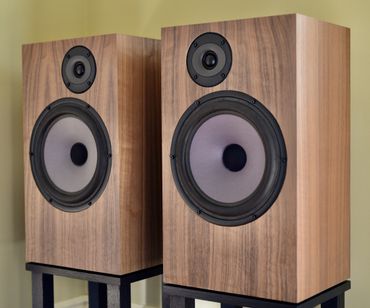
Would you have some advices on what would be a good filtering option for this tweeter to match the A26RE4 soft roll-off? I still want to keep the woofer unfiltered (that was a main motivation for this project) so I guess I don't have any other choice than a 6dB filter? Which values should I go for the cap?
Hello,
so finally after living for almost 7 years with these nice speakers it's time for an upgrade :

Actually the 27TBFC/G tweeter bothers me. Although it is not harsh, after more than 1-2 hours listening sessions I start feeling some hearing fatigue.
Now I'd like to taste the soft dome alternative.
The T35 from the kit is still too expensive and I think it is anyway not the only possibility out there.
I have a good deal on the 29TFF/W that would furthermore perfectly retrofit the 27TBFC/G without any work as it has the same dimensions.
It has been implemented by Annandale Acoustics on its A26se :

Would you have some advices on what would be a good filtering option for this tweeter to match the A26RE4 soft roll-off? I still want to keep the woofer unfiltered (that was a main motivation for this project) so I guess I don't have any other choice than a 6dB filter? Which values should I go for the cap?
Hi,
I believe the tweeter in my Decapos are the 29TFF. I find them bright and detailed; they have been great for watching TV and for parties. I find it is too much of a tweeter for quality music listening: adding a sub to the Decapos really allowed the soundstage to open up. My take is that it is a lot of tweeter and not the most refined sound wise (but awesome for the price)....and I'll go into details.
I recently built my A36 clones (based on the A35 design) with the SEAS T35 tweeter. At about the same time, I landed a pair of Dynaudio Special 40s. What I found with the newer tweeters in both speakers is a much more refined sound; detailed; non fatiguing. If you like to sit down and just listen to music, yes they are expensive, but like anything of quality these days, you gotta pay.
Having spent the extra $$ on the T35 for my A36 clones, I have no regrets. The money is spent and I enjoy them.
As for getting the right capacity value for the job, my kit from Solen came with a 3.3 uf capacitor and a 10 ohm resistor. I went with that and it just works well according to my ears. My Decapos should have a 5 uf cap (I'm using 5.1 uf), no resistor...but I think it should have one! LoL.
If you read up on WD designs A25 clone, the designer keeps referencing phase accuracy at the crossover point between the woofer and tweeter: I guess this is key.
Have you thought to trying a variety of capacitors and resistors to see what works best? I know it is not the best way to go about it, but in the end it will give you the chance to evaluate the variety of combinations.
Best of luck with your decision(s).
I believe the tweeter in my Decapos are the 29TFF. I find them bright and detailed; they have been great for watching TV and for parties. I find it is too much of a tweeter for quality music listening: adding a sub to the Decapos really allowed the soundstage to open up. My take is that it is a lot of tweeter and not the most refined sound wise (but awesome for the price)....and I'll go into details.
I recently built my A36 clones (based on the A35 design) with the SEAS T35 tweeter. At about the same time, I landed a pair of Dynaudio Special 40s. What I found with the newer tweeters in both speakers is a much more refined sound; detailed; non fatiguing. If you like to sit down and just listen to music, yes they are expensive, but like anything of quality these days, you gotta pay.
Having spent the extra $$ on the T35 for my A36 clones, I have no regrets. The money is spent and I enjoy them.
As for getting the right capacity value for the job, my kit from Solen came with a 3.3 uf capacitor and a 10 ohm resistor. I went with that and it just works well according to my ears. My Decapos should have a 5 uf cap (I'm using 5.1 uf), no resistor...but I think it should have one! LoL.
If you read up on WD designs A25 clone, the designer keeps referencing phase accuracy at the crossover point between the woofer and tweeter: I guess this is key.
Have you thought to trying a variety of capacitors and resistors to see what works best? I know it is not the best way to go about it, but in the end it will give you the chance to evaluate the variety of combinations.
Best of luck with your decision(s).
Hi,
I believe the tweeter in my Decapos are the 29TFF. I find them bright and detailed; they have been great for watching TV and for parties. I find it is too much of a tweeter for quality music listening: adding a sub to the Decapos really allowed the soundstage to open up. My take is that it is a lot of tweeter and not the most refined sound wise (but awesome for the price)....and I'll go into details.
I recently built my A36 clones (based on the A35 design) with the SEAS T35 tweeter. At about the same time, I landed a pair of Dynaudio Special 40s. What I found with the newer tweeters in both speakers is a much more refined sound; detailed; non fatiguing. If you like to sit down and just listen to music, yes they are expensive, but like anything of quality these days, you gotta pay.
Having spent the extra $$ on the T35 for my A36 clones, I have no regrets. The money is spent and I enjoy them.
As for getting the right capacity value for the job, my kit from Solen came with a 3.3 uf capacitor and a 10 ohm resistor. I went with that and it just works well according to my ears. My Decapos should have a 5 uf cap (I'm using 5.1 uf), no resistor...but I think it should have one! LoL.
If you read up on WD designs A25 clone, the designer keeps referencing phase accuracy at the crossover point between the woofer and tweeter: I guess this is key.
Have you thought to trying a variety of capacitors and resistors to see what works best? I know it is not the best way to go about it, but in the end it will give you the chance to evaluate the variety of combinations.
Best of luck with your decision(s).
can you say more about how the A36 clone sound compares to the Dynaudio 40's?
I have a good deal on the 29TFF/W that would furthermore perfectly retrofit the 27TBFC/G without any work as it has the same dimensions.
It has been implemented by Annandale Acoustics on its A26se :
Would you have some advices on what would be a good filtering option for this tweeter to match the A26RE4 soft roll-off? I still want to keep the woofer unfiltered (that was a main motivation for this project) so I guess I don't have any other choice than a 6dB filter? Which values should I go for the cap?
Annandale's website say they are running 4th-order crossovers, so it might suit their 29TFFW implementation more than yours.
I've purchased the A26 kit and decided to clone the Dynaco A35; hence I'm calling this project the A36. The cabinets are made of "3 quarter" birch plywood and we kept the cabs to the original Dynaco design; except that we made them just a tad bigger here and there. I've finally got them here tonight as a friend was building the cabs for me. I hooked everything up and was delighted with the T35 tweeter: extended, clear, sweet. The woofer was really tight in the beginning, but after a couple of hours it loosened up and the bass is tuneful now, although not as low in response as I would like. I've still got some work to do to fine tune the speaker, but for the record, it is one of the finest speakers to grace my challenging living room environment. I'm smitten.
Jules, Do you have any photos of your A36 cabinets? I had a pair of A35s a long, long time ago. Wish I still had them. I do have a nice pair of A25s though.
Try this...
My speakers since over 10 years.
Frank
Thanks again the article helped me to find out the right approach.
I fiddled around with the parts I had in house and got very close to Comeau's frequency response, using a much simpler design with only a 2nd order filter on the tweeter and 1st order on the woofer (in addition to the natural roll-off).

So far I am very pleased by the result! I was initially reluctant of adding a filter on the woofer but I gained substantially in definition and it turned out to improve the bass response.
I ran a couple of filter simulations using PCD and something was puzzling me concerning Peter Comeau's filter.
Here are my results :
- My 2nd order filter

- Peter Comeau's filter as on the drawing in his article

- Peter Comeau's filter with inverted tweeter

In this last case we find again the same frequency response as in the article.
So it seems that on his drawing the tweeter should be inverted! Did you notice it?

Anyway, I wonder if it would worth it to implement Peter Comeau's filter as mine gives now very good results.
I really would like to have peoples opinion about Seas 27tffc, 27tdfc or the 29tff tweeter.
I am planning to buy it for the Seas MCA15RCY midrange in a 3-way system and would like to listen musics for long period without harsh, edgy and fatiguing. So I would like to have a smooth, detailed and natural sounding tweeter. Thank you for the help.
I am planning to buy it for the Seas MCA15RCY midrange in a 3-way system and would like to listen musics for long period without harsh, edgy and fatiguing. So I would like to have a smooth, detailed and natural sounding tweeter. Thank you for the help.
Hi.
I have just build me a pair of A26 from Seas. They sound very good upwards. Dynamic and clear. Some of the better speakers I have heard, but for some reason there is little bass. I do not quite know what it comes from, but from what I have read in different forums, there are different experiences with little / enough bass. In my case, I need a subwoofer if they do not magically get better after a few weeks.
Those of you who are familiar with the speaker, is this how it should sound? Have another DIY speaker from the seas with a 6.5 woofer that delivers much more bass than the A26. I know it is not possible to compare these directly, but I expected more than this.
I have just build me a pair of A26 from Seas. They sound very good upwards. Dynamic and clear. Some of the better speakers I have heard, but for some reason there is little bass. I do not quite know what it comes from, but from what I have read in different forums, there are different experiences with little / enough bass. In my case, I need a subwoofer if they do not magically get better after a few weeks.
Those of you who are familiar with the speaker, is this how it should sound? Have another DIY speaker from the seas with a 6.5 woofer that delivers much more bass than the A26. I know it is not possible to compare these directly, but I expected more than this.
There is little bass with the A26 speakers.as.the.enclosures are undersized.for.a sealed alignment. The aperiodic vents cut down on the peak that would occur with the undersized enclosures. There would be.more bass with larger sealed enclosures minus the aperiodic vents. If you want still more bass you could build 100 liter vented enclosures.
There is good coverage of the A26 enclosures here, as well as a member-sponsered set of alternate boxes and a proper A26 box.
Seas A26 Devore Style Build
Plans are in post #51 IIRC.
dave
Seas A26 Devore Style Build
Plans are in post #51 IIRC.
dave
A new pair of Seas A26's enters the world
I built the Madisound Seas A26 kit a few weeks ago as spec'd: T35C-002 tweeter crossed with 3.3uF Mundorf Supremes and 10R resistor in series, no cross on the A26RE4 mid-woofers. The 28L cherry veneer cabinet has no internal bracing- I contacted one cabinet maker to see if they would make ones per planet10's plans but I got no response. The cabinet has the aperiodic vent which I sealed with the same foam that I lined the cabinet with, per Madisound's instruction. Crossover mounted on the backs of the input cups as planet10 suggested, but there is no foam lining on the back of the cabinet- the kit didn't come with enough to line the backs.
Compared to the Klipsch RP-150M bookshelf speakers I was running, the sound of the A26's is far more detailed, with better soundstage and balance. Vocals are a touch less forward but that seems reasonable given the better overall perceived frequency response. Jazz and instrumental music sounds superior. I drive my system with a single Pass ACA and was worried that the lower sensitivity of these speakers compared to the Klipsch would present an issue, but not at all- my volume settings are hardly changed. I also don't regret hardwiring the 10R resistors in the crossover as I don't think the treble response needs any changing. Highly recommend to anyone considering this speaker.
I built the Madisound Seas A26 kit a few weeks ago as spec'd: T35C-002 tweeter crossed with 3.3uF Mundorf Supremes and 10R resistor in series, no cross on the A26RE4 mid-woofers. The 28L cherry veneer cabinet has no internal bracing- I contacted one cabinet maker to see if they would make ones per planet10's plans but I got no response. The cabinet has the aperiodic vent which I sealed with the same foam that I lined the cabinet with, per Madisound's instruction. Crossover mounted on the backs of the input cups as planet10 suggested, but there is no foam lining on the back of the cabinet- the kit didn't come with enough to line the backs.
Compared to the Klipsch RP-150M bookshelf speakers I was running, the sound of the A26's is far more detailed, with better soundstage and balance. Vocals are a touch less forward but that seems reasonable given the better overall perceived frequency response. Jazz and instrumental music sounds superior. I drive my system with a single Pass ACA and was worried that the lower sensitivity of these speakers compared to the Klipsch would present an issue, but not at all- my volume settings are hardly changed. I also don't regret hardwiring the 10R resistors in the crossover as I don't think the treble response needs any changing. Highly recommend to anyone considering this speaker.
Attachments
I have built the A26 kit with the T35 Seas tweeter and its pretty amazing sounding for such a simple design. That's probably why its so good. It just sounds correct and musical without a trace of listening fatigue. The cabinet tuning is a bit lean on the low end, but getting them closer to a boundary helps alot. I run them spaced only 1 ft from the rear wall. No issues with excess lower mids.
but there is no foam lining on the back of the cabinet- the kit didn't come with enough to line the backs.
The Dynaco A25s were stuffed to the gills with thick fiberglass batting, sides, top, bottom and back. Granted chipboard rather MDF, and slightly different dimensions I believe. You could give it try, cheap tweak and see what you hear.
Attachments
- Home
- Loudspeakers
- Multi-Way
- SEAS A26 Speaker Kit
